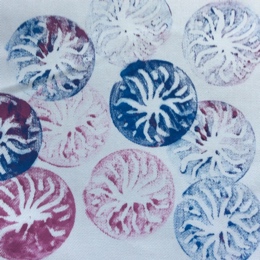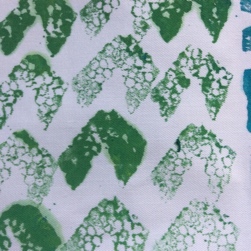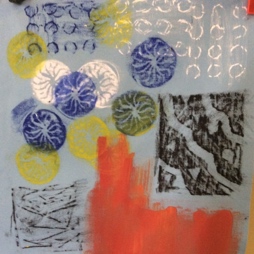18 Nov 2014
This entry addresses the questions at the end of Project 5: Printing and painting.
1) Do you feel you made a good selection from your drawings to use as source material for your designs? Which interpretations worked best? Why?
I am pleased with my selections. The four designs I chose (two from Project 4, stage 4, two new designs) provided scope for experimenting with different printing and painting techniques. I am most pleased with the sunflower interpretation. This was a new design and I applied the techniques which I had learnt earlier in the course to develop the ideas. I used mono-printing, freehand painting and a lino-cut as a print-block for these designs, which were well balanced and lively.
2) Which fabrics did you choose? What particular qualities appealed to you?
I used faux suede, needlecord, calico, linen, cotton drill, cotton muslin, cotton of various weights, sheer synthetic, loose weave synthetic and vilene. I particularly liked the sheerness of the cotton muslin combined with it’s loose weave – pressing down with a lino-roller on the acetate during mono-printing gave interesting marks from the edges of the roller. I also liked using taffeta when making rubbings using Markal paint-sticks – the fabric which seemed to accentuate their ‘buttery’ texture.
In each instance, the suitability of fabric depended on the type of mark, the medium with which the marks were made,, and how they were applied (i.e. brushes, rubbing, scraper)
3) Is the scale of marks and shapes on your samples appropriate to the fabric? Would any of your ideas work better on a different type of fabric, for example, sheer, textured, heavyweight? Why? Do the marks and shapes seem well placed, too crowded, or too far apart? Were you aware of negative shapes that were forming in between the positive shapes? What elements are contrasting and what elements are harmonising in each sample? Is there a balance between the two that produces an interesting tension?
I feel that I chose fabric pieces which were appropriate to the scale of the marks. I tried a wide variety of fabrics, so I am content that I have explored the suitability of most fabric types for the different methods of printing and mark-making. For example, the ‘tiger stripes’ worked well on the faux suede fabric with mono-prints and direct marks using Markal paint-sticks. This fabric gave poor results when Markal rubbings were made on it using the ‘lichen’ design and cardboard raised shape/stencil.
In general I was pleased with the spacing of the shapes. In the ‘lichen’ design, I tried both spacing the stencils and overlapping them. Both worked and gave different dimensions to the print, and different negative shapes. When I used freezer paper as a stencil and decorated the background with fabric paints the plain masked off images were very bold and of high contrast. I felt this was too much. I ‘calmed’ subsequent prints by patterning the background before masking, or applying additional prints/patterning after removing the masking paper. This gave a balance between contrast and harmony of colour and pattern.
4) How successful do you think your larger sample is? Do you like the design? Have you recreated or extended your ideas from the smaller samples so that there is a visible development between the two? Does your repeating design flow across the surface without obvious internal edges? or do the shapes and marks in your single unit sample related well to the size and shape of the fabric? Do they make an interesting composition on this scale.
I made two larger samples. I was quite pleased with the ”single unit’ print, although I think it may have been better as a series of printed rectangles with different colours and textures, rather than having been made in the style of a painting. I did a lot of samples with different techniques and fabrics before starting the final piece, so I am satisfied that I explored different possibilities and that progression can be seen between design ideas and final piece.
I would say that my repeating design does flow across the surface without obvious internal edges, because the repeat for different aspects of the print (i.e. rose design, trellis, leaves) are all different. I think that the rose design (rubbings) part of the print is still too solid and that there needs to be more movement in the design. Maybe a way to do this would be to replace the lino-cut rubbings with a softer, less bold rose image. I think that the scale of the pattern is good and that the size of the pattern repeat would work well on soft furnishings.



















































